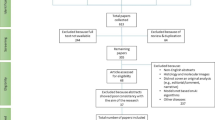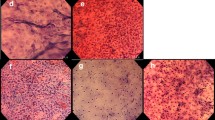Abstract
Randomized trials have demonstrated that ablation of dysplastic Barrett’s esophagus can reduce the risk of progression to cancer. Endoscopic resection for early stage esophageal adenocarcinoma and squamous cell carcinoma can significantly reduce postoperative morbidity compared to esophagectomy. Unfortunately, current endoscopic surveillance technologies (e.g., high-definition white light, electronic, and dye-based chromoendoscopy) lack sensitivity at identifying subtle areas of dysplasia and cancer. Random biopsies sample only approximately 5% of the esophageal mucosa at risk, and there is poor agreement among pathologists in identifying low-grade dysplasia. Machine-based deep learning medical image and video assessment technologies have progressed significantly in recent years, enabled in large part by advances in computer processing capabilities. In deep learning, sequential layers allow models to transform input data (e.g., pixels for imaging data) into a composite representation that allows for classification and feature identification. Several publications have attempted to use this technology to help identify dysplasia and early esophageal cancer. The aims of this reviews are as follows: (a) discussing limitations in our current strategies to identify esophageal dysplasia and cancer, (b) explaining the concepts behind deep learning and convolutional neural networks using language appropriate for clinicians without an engineering background, (c) systematically reviewing the literature for studies that have used deep learning to identify esophageal neoplasia, and (d) based on the systemic review, outlining strategies on further work necessary before these technologies are ready for “prime-time,” i.e., use in routine clinical care.

Similar content being viewed by others
References
Arnold M, Soerjomataram I, Ferlay J, Forman D. Global incidence of oesophageal cancer by histological subtype in 2012. Gut. 2015;64:381–387.
Cotton CC, Wolf WA, Overholt BF, et al. Late recurrence of Barrett’s esophagus after complete eradication of intestinal metaplasia is rare: final report from ablation in intestinal metaplasia containing dysplasia trial. Gastroenterology. 2017;153:681–688.
Phoa KN, Rosmolen WD, Weusten B, et al. The cost-effectiveness of radiofrequency ablation for Barrett’s esophagus with low-grade dysplasia: results from a randomized controlled trial (SURF trial). Gastrointest Endosc. 2017;86:120–129.
Naveed M, Kubiliun N. Endoscopic treatment of early-stage esophageal cancer. Curr Oncol Rep. 2018;20:71.
Shaheen NJ, Falk GW, Iyer PG, Gerson LB, American College of G. ACG clinical guideline: diagnosis and management of Barrett’s esophagus. Am J Gastroenterol. 2016;111:30–50. (quiz 1).
Domper Arnal MJ, Ferrandez Arenas A, Lanas Arbeloa A. Esophageal cancer: Risk factors, screening and endoscopic treatment in Western and Eastern countries. World J Gastroenterol. 2015;21:7933–7943.
Sharma N, Ho KY. Recent updates in the endoscopic diagnosis of Barrett’s oesophagus. Gastrointest Tumors. 2016;3:109–113.
Wani S, Williams JL, Komanduri S, Muthusamy VR, Shaheen NJ. Endoscopists systematically undersample patients with long-segment Barrett’s esophagus: an analysis of biopsy sampling practices from a quality improvement registry. Gastrointest Endosc. 2019;90:732–741.
Davila RE. Chromoendoscopy. Gastrointest Endosc Clin N Am. 2009;19:193–208.
Goldblum JR, Shaheen NJ, Vennalaganti PR, Sharma P, Lightdale CJ. WATS for Barrett’s surveillance. Gastrointest Endosc. 2018;88:201–202.
Committee AT, Thosani N, Abu Dayyeh BK, et al. ASGE Technology Committee systematic review and meta-analysis assessing the ASGE preservation and incorporation of valuable endoscopic innovations thresholds for adopting real-time imaging-assisted endoscopic targeted biopsy during endoscopic surveillance of Barrett’s esophagus. Gastrointest Endosc. 2016;83:684–698.
Ferguson DD, DeVault KR, Krishna M, Loeb DS, Wolfsen HC, Wallace MB. Enhanced magnification-directed biopsies do not increase the detection of intestinal metaplasia in patients with GERD. Am J Gastroenterol. 2006;101:1611–1616.
Sanghi V, Thota PN. Barrett’s esophagus: novel strategies for screening and surveillance. Ther Adv Chronic Dis. 2019;10:2040622319837851.
Patel V, Khan MN, Shrivastava A, et al. Artificial intelligence applied to gastrointestinal diagnostics: a review. J Pediatr Gastroenterol Nutr. 2020;70:4–11.
Hubel DH, Wiesel TN. Receptive fields, binocular interaction and functional architecture in the cat’s visual cortex. J Physiol. 1962;160:106–154.
Zeiler MD, Fergus R. Visualizing and understanding convolutional networks. Eur Conf Comput Vis. 2014;8689:818–833.
Goldblum JR. Controversies in the diagnosis of Barrett esophagus and Barrett-related dysplasia: one pathologist’s perspective. Arch Pathol Lab Med. 2010;134:1479–1484.
Deo RC. Machine learning in medicine. Circulation. 2015;132:1920–1930.
Wani S, Rubenstein JH, Vieth M, Bergman J. Diagnosis and management of low-grade dysplasia in Barrett’s esophagus: expert review from the clinical practice updates committee of the american gastroenterological association. Gastroenterology. 2016;151:822–835.
Shah T, Lippman R, Kohli D, Mutha P, Solomon S, Zfass A. Accuracy of probe-based confocal laser endomicroscopy (pCLE) compared to random biopsies during endoscopic surveillance of Barrett’s esophagus. Endosc Int Open. 2018;6:E414–E420.
Vennalaganti P, Kanakadandi V, Goldblum JR, et al. Discordance among pathologists in the United States and Europe in diagnosis of low-grade dysplasia for patients with Barrett’s Esophagus. Gastroenterology. 2017;152:564–570.
Litjens G, Bandi P, Ehteshami Bejnordi B, et al. 1399 H&E-stained sentinel lymph node sections of breast cancer patients: the CAMELYON dataset. Gigascience. 2018;7:giy065.
Moher D, Liberati A, Tetzlaff J, Altman DG, Group P. Preferred reporting items for systematic reviews and meta-analyses: the PRISMA statement. Ann Intern Med. 2009;151:264–269.
de Groof AJ, Struyvenberg MR, Fockens KN, et al. Deep learning algorithm detection of Barrett’s neoplasia with high accuracy during live endoscopic procedures: a pilot study (with video). Gastrointest Endosc. 2020;91:1242–1250.
de Groof AJ, Struyvenberg MR, van der Putten J, et al. Deep-learning system detects neoplasia in patients with Barrett’s esophagus with higher accuracy than endoscopists in a multistep training and validation study with benchmarking. Gastroenterology. 2020;158:915–929.
de Groof J, van der Sommen F, van der Putten J, et al. The Argos project: the development of a computer-aided detection system to improve detection of Barrett’s neoplasia on white light endoscopy. United Eur Gastroenterol J. 2019;7:538–547.
Sali R, Moradinasab N, Guleria S, Ehsan L, Fernandes P, Shah T, Syed S, Brown DE. Deep learning for whole slide tissue histopathology classification: a comparative study in identification of dysplastic and non-dysplastic Barrett’s esophagus. J Pers Med. Accepted manuscript.
Zhang CML, Uedo N, Matsuura N, Tam P, Teoh AY. The use of convolutional neural artificial intelligence network to aid the diagnosis and classification of early esophageal neoplasia. A feasibility study. Gastrointestinal Endosc. 2017;85:AB581–AB582.
Mendel R, Ebigbo A, Probst A, Messmann H, Palm C. Barrett’s Esophagus analysis using convolutional neural networks. Bildverarbeitung für die Medizin. 2017:80-5.
Ebigbo A, Mendel R, Probst A, et al. Computer-aided diagnosis using deep learning in the evaluation of early oesophageal adenocarcinoma. Gut. 2019;68:1143–1145.
Everson M, Herrera L, Li W, et al. Artificial intelligence for the real-time classification of intrapapillary capillary loop patterns in the endoscopic diagnosis of early oesophageal squamous cell carcinoma: a proof-of-concept study. United Eur Gastroenterol J. 2019;7:297–306.
Guo L, Wu C, Xiao X, et al. Automated detection of precancerous lesion and early esophageal squamous cancer using a deep learning model. Am J Gastroenterol. 2018;113:S173–S174.
Horie Y, Yoshio T, Aoyama K, Fujisaki J, Tada T. Application of artificial intelligence using convolutional neural networks in the detection of esophageal cancer. Gastrointestinal Endosc. 2018;87:AB538.
Cai SL, Li B, Tan WM, et al. Using a deep learning system in endoscopy for screening of early esophageal squamous cell carcinoma (with video). Gastrointest Endosc. 2019;90:745–753.
Ghatwary N, Zolgharni M, Ye X. Early esophageal adenocarcinoma detection using deep learning methods. Int J Comput Assist Radiol Surg. 2019;14:611–621.
Horie Y, Yoshio T, Aoyama K, et al. Diagnostic outcomes of esophageal cancer by artificial intelligence using convolutional neural networks. Gastrointest Endosc. 2019;89:25–32.
Liu DY, Jiang H, Rao N, Luo C, Du W, Li Z, et al. Computer aided annotation of early esophageal cancer in gastroscopic images based on Deeplabv3+ network. ICBIP ‘19: Proceedings of the 2019 4th International Conference on Biomedical Signal and Image Processing (ICBIP 2019). 2019: pp 56–61.
Shiroma S, Yoshio T, Aoyama K, Tsuchida T, Fujisaki J, Tada T. The application of artificial intelligence to detect esophageal squamous cell carcinoma in movies using convoluntional neural networks. Gastrointest Endosc. 2019;89:AB89.
Struyvenberg MRDG, Van Der Putten J, Van Der Sommen F, et al. Deep learning algorithm for characterization of barrett’s neoplasia demonstrates high accuracy on NBI-zoom images. Gastroenterology. 2019;156:S-58.
Tang DW, Wang L, He G, et al. Artificial intelligence network to aid the diagnosis of early esophageal squamous cell carcinoma and esophageal inflammations in white light endoscopic images. Gastrointestinal Endosc. 2019;89:AB654.
Ebigbo A, Mendel R, Probst A, et al. Real-time use of artificial intelligence in the evaluation of cancer in Barrett’s oesophagus. Gut. 2020;69:615–616.
Guo L, Xiao X, Wu C, et al. Real-time automated diagnosis of precancerous lesions and early esophageal squamous cell carcinoma using a deep learning model (with videos). Gastrointest Endosc. 2020;91:41–51.
Ohmori M, Ishihara R, Aoyama K, et al. Endoscopic detection and differentiation of esophageal lesions using a deep neural network. Gastrointest Endosc. 2020;91:301–309.
Hashimoto R, Requa J, Dao T, et al. Artificial intelligence using convolutional neural networks for real-time detection of early esophageal neoplasia in Barrett’s esophagus (with video). Gastrointest Endosc. 2020;91:1264–1271.
Iwagami H, Ishihara R, Aoyama K, Fukuda H, Shimamoto Y, Kono M, et al. Artificial intelligence for the detection of esophageal and esophagogastric junctional adenocarcinoma. J Gastroenterol Hepatol. 2020.
Acknowledgments
John Cyrus (Research and Education Librarian): Assisted in literature search of following databases: Pubmed/Medline, Embase, Cochrane library and Web of Science for studies. Tilak Shah: ASGE, McGuire Research Institute. Research contract with Allergan. Sana Syed: K23DK117061-01A1 (SS) National Institute of Diabetes and Digestive and Kidney Diseases (NIDDK) of the National Institutes of Health.
Funding
None.
Author information
Authors and Affiliations
Corresponding author
Additional information
Publisher's Note
Springer Nature remains neutral with regard to jurisdictional claims in published maps and institutional affiliations.
Rights and permissions
About this article
Cite this article
Syed, T., Doshi, A., Guleria, S. et al. Artificial Intelligence and Its Role in Identifying Esophageal Neoplasia. Dig Dis Sci 65, 3448–3455 (2020). https://doi.org/10.1007/s10620-020-06643-2
Received:
Accepted:
Published:
Issue Date:
DOI: https://doi.org/10.1007/s10620-020-06643-2




